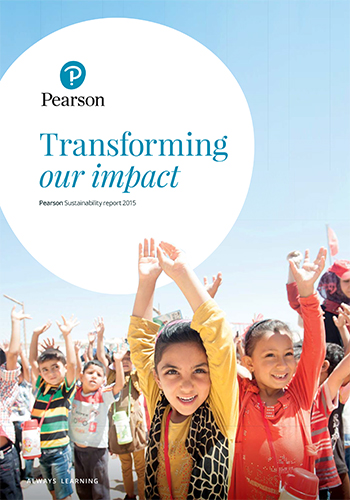Pearson Launches 2015 Sustainability Report
Published 07-11-16
Issued by Pearson
Summary
Pearson, the world’s learning company, today launches its 2015 Sustainability Report, which aims to advance the conversation about what sustainability looks like in the education industry.
Report Highlights
2015 report announces new five year ‘sustainability plan’ to help transform the company’s impact in the future
Pearson, the world’s learning company, today launches its 2015 Sustainability Report, which aims to advance the conversation about what sustainability looks like in the education industry.
This report introduces Pearson’s new five year plan to integrate sustainability into every aspect of its business and to help drive forward the United Nation’s 2030 Sustainable Development Goals (SDGs) through contributing educational expertise, knowledge and resources to address key global sustainability challenges.
Pearson’s new sustainability plan is based on a review carried out in 2015, It uses three key UN SDGs (4-Quality education, 8-Decent work and economic growth, 10-Reduced inequalities), to ensure Pearson focuses its efforts where it can have the greatest impact. The new strategy demonstrates Pearson’s contributions to help achieve these and other sustainability goals.
The three pillars that guide Pearson’s refined sustainability aspirations are:
- Be a trusted partner- Pearson seeks to operate responsibly, transparently, and with integrity in everything we do.
This is the foundation for establishing and maintaining the trust of our shareholders, employees, suppliers, customers, learners, and partners, and for earning our license to operate in communities around the world.
- Reach more learners- Pearson has a long-term growth objective to reach 200 million learners annually by 2025 - more than doubling our reach. This will require innovation in all aspects of our business. Our product development processes foster creative and rigorous solutions to education challenges. The expansion of our digital product offerings allows us to make products more accessible, affordable, and effective. We will also collaborate with organizations across sectors to address some of the biggest education challenges, including illiteracy, gender inequality, and education in conflict and emergency settings.
- Shape the future of education- To remain at the forefront of these changes, Pearson will constantly review, refine, and evolve our products and services to ensure they provide the best outcomes for learners. We will also invest in and develop new technologies to make learning as personalized, adaptive and effective as possible, and provide the 21st century skills learners require for success. To remain at the forefront of these changes, we will share insights and learn from others in order to shape the global education agenda.
Pearson will develop goals and targets to deliver impact against these three pillars, and report on progress against these annually in forthcoming sustainability reports.
Amanda Gardiner, VP of Sustainability and Social Innovation at Pearson, said: “At Pearson, we know that learning changes lives. Our 2020 Sustainability Plan integrates and informs our business priorities, challenging us to maximize our contribution to the delivery of quality education for all, and to the creation of a better, more sustainable world. We will use the plan to focus activity in areas where we can deliver the most value for stakeholders and the greatest positive impact.”
To read Pearson’s full 2015 Sustainability Report and learn about its new five-year ‘sustainability plan’, visit https://www.pearson.com/social-impact/2015-report.html.
Pearson
Pearson
x


